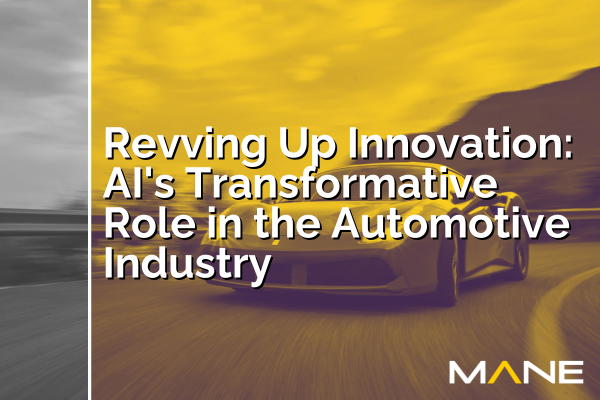Revving Up Innovation: AI's Transformative Role in the Automotive Industry
21 Jun, 20245minsRevving Up Innovation: AI's Transformative Role in the Automotive IndustryThe automotive...

Revving Up Innovation: AI's Transformative Role in the Automotive Industry
The automotive industry is undergoing a seismic shift, propelled by the rapid integration of artificial intelligence (AI). From autonomous vehicles to enhanced manufacturing processes, AI is redefining the very essence of transportation. This transformative technology is not only improving vehicle safety and performance but also revolutionising the entire user experience. As an automotive recruitment agency, we recognise the importance of staying abreast of these cutting-edge AI technologies and their applications. In this article, we'll explore the myriad ways in which AI is driving innovation in the automotive sector.
The Rise of Autonomous Vehicles:
At the forefront of AI's impact on the automotive industry is the development of autonomous or self-driving vehicles. These technologically advanced cars utilise sophisticated AI algorithms and machine learning to interpret vast amounts of sensor data, enabling them to navigate roads, avoid obstacles, and make split-second decisions without human intervention. Industry giants like Tesla, Waymo, and others are leading the charge in refining AI models to enhance the safety and reliability of autonomous driving systems. While fully autonomous vehicles (Level 5) are still in the testing phase, the market for partially autonomous cars (Levels 1-4) is rapidly expanding, with projections indicating significant growth in the coming years.
Core AI Technologies Enabling Autonomous Vehicles:
Several key AI technologies are at the heart of enabling autonomous vehicles:
1. Machine Learning (ML): ML algorithms allow AVs to identify patterns in enormous amounts of driving data, continuously improving their decision-making capabilities. This enables vehicles to handle a wide range of driving scenarios, from recognising pedestrians to interpreting traffic signs.
2. Computer Vision: By leveraging cameras and sensors, computer vision technology empowers AVs to "see" and make sense of their surroundings. This includes detecting obstacles, lane markings, and other vehicles, which is essential for safe navigation.
3. Deep Learning: As a subset of ML, deep learning utilises neural networks to mimic human-like learning. Deep learning models are trained on extensive datasets, allowing AVs to make nuanced driving decisions and constantly improve their performance.
4. Sensor Fusion: AI algorithms integrate data from various sensors, such as LiDAR, radar, and cameras, to create a comprehensive understanding of the vehicle's environment. This fusion of data ensures more accurate and reliable operation.
Level 2 Autonomy: A Stepping Stone:
While fully autonomous vehicles capture the imagination, Level 2 autonomy is already making a significant impact on the automotive landscape. Level 2 autonomous vehicles are equipped with advanced driver assistance systems (ADAS) that can control steering, acceleration, and braking in specific scenarios, such as adaptive cruise control and lane-keeping assistance. However, the driver must remain attentive and ready to take control at any moment. Level 2 autonomy serves as a crucial stepping stone, allowing manufacturers to refine AI technologies and build consumer trust in the journey towards higher levels of autonomy.
AI-Powered Manufacturing and Quality Control:
Beyond the realm of self-driving cars, AI is also revolutionising the manufacturing processes within the automotive industry. Intelligent robots equipped with AI capabilities are being deployed to streamline assembly lines, ensuring unparalleled precision and efficiency. Moreover, AI-driven predictive maintenance systems can proactively identify potential machinery failures, minimising downtime and optimising production workflows. Quality control is another area where AI shines, with advanced algorithms meticulously inspecting vehicles to guarantee adherence to the highest standards of safety and performance.
Enhanced Safety Features and Driver Assistance:
AI's contributions to vehicle safety extend far beyond autonomous driving. Advanced driver-assistance systems (ADAS), powered by AI, are becoming increasingly commonplace in modern vehicles. Features such as automatic emergency braking, lane departure warnings, adaptive cruise control, and pedestrian detection rely on AI to analyse real-time data from cameras and sensors, dramatically enhancing driver awareness and reducing the risk of accidents. As AI technology continues to evolve, these safety systems are becoming more sophisticated, offering unprecedented levels of protection and peace of mind to vehicle occupants.
Personalised Experiences and Seamless Connectivity:
AI is also transforming the in-vehicle experience, ushering in an era of unparalleled personalisation and connectivity. By leveraging data on driver behaviour and preferences, AI-powered systems can automatically adjust seat positions, climate control settings, and multimedia preferences to create a tailored environment for each individual. Voice-activated assistants, powered by natural language processing, allow drivers to effortlessly control navigation, communication, and entertainment functions, ensuring a seamless and hands-free experience. As vehicles become increasingly connected, AI enables the integration of smart home devices, allowing drivers to remotely control their homes from the comfort of their cars.
Predictive Maintenance and Fleet Management:
The benefits of AI extend beyond individual vehicles, revolutionising fleet management and maintenance practices. Predictive maintenance systems, powered by AI algorithms, analyse vast amounts of data from vehicle sensors to forecast when specific components might fail or require servicing. By proactively addressing potential issues before they escalate, fleet managers can significantly reduce downtime, optimise vehicle performance, and extend the overall lifespan of their assets. AI-driven fleet management solutions also enable real-time monitoring, route optimisation, and efficient resource allocation, leading to substantial cost savings and improved operational efficiency.
Challenges and Future Prospects:
While the integration of AI in the automotive industry holds immense promise, it is not without challenges. Concerns regarding data privacy, cybersecurity, and the ethical implications of autonomous decision-making must be carefully addressed. Rigorous testing, regulatory frameworks, and public trust-building initiatives will be crucial in ensuring the safe and responsible deployment of AI-powered vehicles. Additionally, the high costs associated with AI technology and the need for specialised talent may initially hinder widespread adoption. However, as AI continues to advance and becomes more accessible, its transformative impact on the automotive industry is poised to accelerate, reshaping the future of mobility.
The convergence of artificial intelligence and the automotive industry marks a pivotal moment in the evolution of transportation. From enhancing vehicle safety and performance to enabling autonomous driving and personalised experiences, AI is driving innovation at an unprecedented pace. As manufacturers, tech companies, and researchers collaborate to overcome challenges and unlock the full potential of AI, we stand on the cusp of a new era of mobility – one characterised by unparalleled efficiency, convenience, and sustainability. As an automotive recruitment agency, we understand the importance of staying informed about these groundbreaking developments. The road ahead is filled with exciting possibilities, and AI will undoubtedly be the key to navigating this transformative journey. For professionals in the automotive industry, embracing and adapting to these AI-driven changes will be essential for success in this rapidly evolving landscape.


